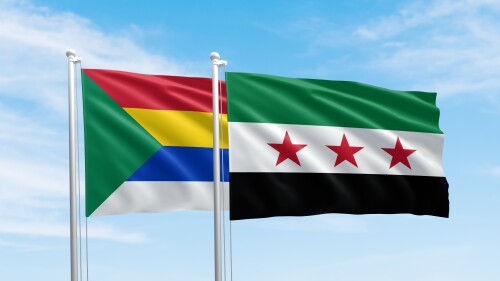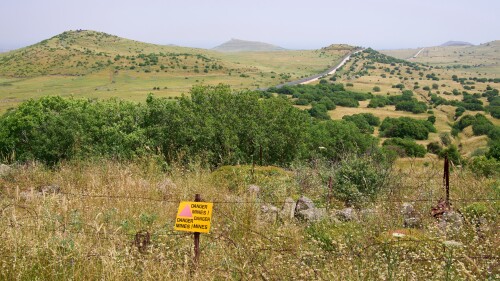The Syrian government is not the only actor to be facing sustained protests against its rule. In the ‘liberated’ northwest of Syria- specifically the region of Idlib and its environs- there have been widespread demonstrations over the past three months or so against some of the policies of Hay’at Tahrir al-Sham, the dominant insurgent faction, led by Abu Muhammad al-Jowlani. Hay’at Tahrir al-Sham exercises authority not only through its military wing but also various bodies that are nominally independent but in fact backed and controlled by the group, such as the ‘Salvation Government’ and the ‘Public Security Apparatus.’ Ultimately, the status quo in the northwest- sustained since 2020 by a ceasefire arrangement brokered between Russia and Turkey- has given rise to a system that has many parallels with how Hamas governed Gaza prior to Israel’s latest military campaign: one faction exerting hegemony and implementing an Islamist, authoritarian mode of governance.
Unsurprisingly, such a status quo in Idlib and its environs has generated considerable dissatisfaction for a variety of reasons. For their part, supporters of Abu Muhammad al-Jowlani have tried to frame the protests as somehow influenced and driven by ‘malign’ actors. To discuss the protests further, I conducted an interview on 21 May with Abu Muhammad Nasr, originally from Aleppo, a critic of Abu Muhammad al-Jowlani and a supporter of the protests. He was part of the wing of the jihadist group Jabhat Ansar al-Din that broke with Hay’at Tahrir al-Sham.
Q: For how long have the protests continued in the north, in which areas have they spread and do these protests consist of large crowds?
A: In the name of God. Praise be to God and prayers and peace be upon the Messenger of God, his family, companions and those who are loyal to him. As for what follows:
The level of the demonstrations has intensified over the past three months. Of course, before this, there were demonstrations coming out in some areas to demand the release of detainees and there were other demands. But for the recent popular mobilisation, its first demonstrations came out on 25 February 2024.
As for the crows, there are large crowds coming out in Idlib and Binnish, as well as Taftanaz and al-Fu’a and other areas. Recently, the central demonstrations have been coming out in the middle of Idlib city at the Clock Square. In these demonstrations, large numbers come out, estimated in the thousands. Simultaneously, demonstrations come out in the rest of the towns and localities. The demonstrations that have come out have not called to bring down the Hay’a, and their problem is not with the Hay’a’s soldiers performing sentinel duty on the frontlines, but rather they have four demands well-known to all.
Q: What are the main reasons for the demonstrations? In other words what are the most important grievances? Have the demands become tantamount to calling to bring down al-Jowlani’s government?
A: The main reasons are many, including the widespread oppression, the unjustified arrest and torture of revolutionaries, honest ones and mashaykh, and the dictatorship and tyranny represented in one-man rule, as well as the failure on all levels, the politicised judiciary, the superficial Shura that works to consolidate the pillars of oppression, and al-Jowlani’s illegitimate control of the leadership of the liberated areas. The final remaining reason for the coming out of the demonstrations is the issue of the innocent agents, and the killing of the mujahid Abd al-Qadir al-Hakim- affiliated with Jaysh al-Ahrar- inside al-Jowlani’s prisons. He was killed under torture in the prisons of the Public Security Apparatus on accusation of collaboration, then his innocence became apparent after he was killed. After all we have mentioned, the demonstrations came out, and the revolutionaries have agreed on four demands, namely:
1. Bringing down al-Jowlani
2. Dissolving the Public Oppression Apparatus.
3. Releasing the oppressed detainees and prisoners of conscience from al-Jowlani’s prisons.
4. Forming a real Shura council to administer the liberated areas.
And since al-Jowlani is the reason for all that is happening, the people’s first demand has been to bring him down.
Q: Some of al-Jowlani’s supporters say that other factions are participating in the demonstrations, such as Hizb-ut-Tahrir, Jaysh al-Ahrar and Hurras al-Din. Do these words have any relation to what is actually happening on the ground? Some also say that Turkey is trying to pressure the Hay’a so that it will become subject to it like the ‘Syrian National Army.’ What do you think of that?
A: It is natural that some members of the factions and Hizb-ut-Tahrir should participate in the demonstrations, as they have been faced oppression, subjugation, arrest and killing at the hands of al-Jowlani and his Public Oppression Apparatus, but they are “part of the whole.” For the recent movement is a popular movement par excellence, and those leading it are among the best revolutionaries, academics and clerics, known for their revolutionary spirit, and the members of factions and parties are part of the people and have demands, rights and grievances as well. Is it al-Jowlani’s right to oppress, arrest and kill, and not the right of the followers of the factions to demand their rights?
As for pressuring the Hay’a to submit, the popular movement has no link to this. For the people are not anyone’s vehicle, and they do not serve anyone’s agendas. All know that al-Jowlani offers services and compromises to all without pressure, so one should rule out the notion that the popular movement is a form of leverage against him.
Q: How has the Hay’a responded to the demonstrations? There is talk about reform: do you expect anything from this angle? What were the most important changes in the system of administration before the start of the demonstrations?
A: It is more correct for us to say: how has al-Jowlani responded to the demonstrations? Of course he has tried to get around the demonstrations and made promises for reform, but these promises are false, for the reforms he undertook were superficial, with the aim of them being to continue the imposition of his rule over the liberated areas, and to continue the oppression, tyranny and corruption. After he was unable to silence the people with false promises, he resorted to force, violence and repression. This began when al-Jowlani’s personnel forcibly dispersed the demonstrations in front of the military government, and Shaykh Abu al-Walid al-Hanafi was struck on his head in an attempt to kill him: he is one of the clerical symbols of the popular movement. The men and women were struck and humiliated, and the sit-in was seeking to demand the release of prisoners. Last Friday, which was under the title of “Your terrorism does not break out will,” al-Jowlani mobilised his soldiers, and cut the connections between the towns and localities, and he prepared the tools of repression in order to prevent the people coming out in demonstrations. but the demonstrations came out by the grace of God Almighty, and the demonstrators tried to come out from ‘Binnish’ and other locations in order to reach the central demonstration in Idlib, but al-Jowlani’s soldiers were lying in wait for them, and the demonstrators were assaulted on the peripheries of Binnish with sticks and knives and run over with armoured vehicles, just as the criminal regime used to do when the demonstrations came out against it. All this is documented on videos in the revolutionaries’ possession, and Shaykh Abu al-Walid al-Hanafi and Dr. Faruq Kishkish were arrested. Dr. Faruq is one of the academic symbols in the movement. Subsequently both were released. And praise be to God, all the attempts to suppress the demonstrations have failed.
As for the changes in the administrative system before and after the demonstrations, they are the same. They are basically “pen on paper” and nothing more. Decisions and reforms are issued but on the ground none of them are implemented. As I have mentioned to you, they are false promises made by al-Jowlani so he can remain chief authority.
Q: What is your message to the Hay’a and the demonstrators?
A: My message to the Hay’a’s soldiers on sentinel duty on the frontlines: the people have not come out to bring you down. You are part of us and we are part of you. Rather, they have come out to bring down al-Jowlani and the sowers of corruption who are with him. Even you have not been safe from the oppression of the Public Security Apparatus, which has arrested you and accused you of collaboration. So stand with your brothers in the popular movement, for there is all good in bringing down oppression, corruption and tyranny, and spreading justice and good, in that all should be in one trench to achieve the aims of our revolution, the chief aim being to bring down the criminal regime.
As for my message to my protesting brethren in the popular movement, be unified and united. Beware of abandoning any of the four demands that are bringing down al-Jowlani, dissolving the Public Oppression Apparatus, releasing the oppressed detainees from the prisons, and forming a real Shura council. So abandoning any of these demands means continuation of repression, oppression, arrest, and dictatorship. And praise be to God the Lord of the Worlds.



![Jamal Maarouf: “When Daesh [ISIS] stood as a firm stumbling block before us and prevented us from continuing the fight against Bashar’s army, we had to fight it and expel it from Idlib and its countryside, Hama countryside, Jabal al-Turkoman [in Latakia] and Aleppo countryside.” Above: Aleppo, Syria, March 12, 2016. Military convoys of the Syrian opposition forces head to fight ISIS.](https://cdn-mef.meforum.org/dims4/default/3b369ca/2147483647/strip/true/crop/5246x2948+2+0/resize/500x281!/brightness/10x0/quality/90/?url=https%3A%2F%2Fk2-prod-mef.s3.us-east-1.amazonaws.com%2Fbrightspot%2Fcd%2F92%2Fb95ba9514dbdb21456f4274a85c6%2Fsyrian-opposition-forces-03-12-2016.jpg)



